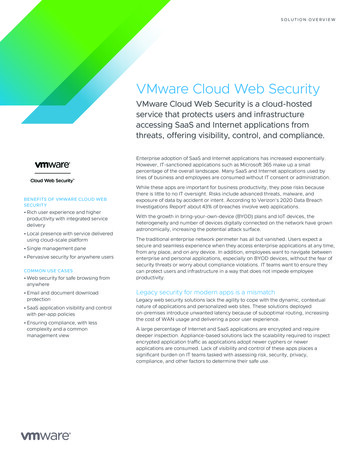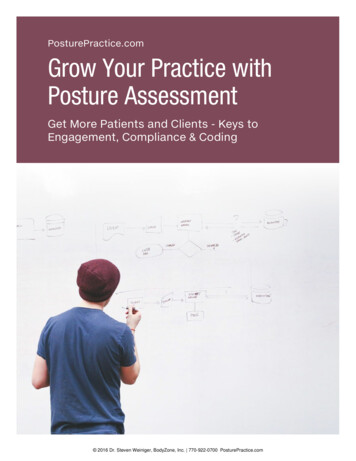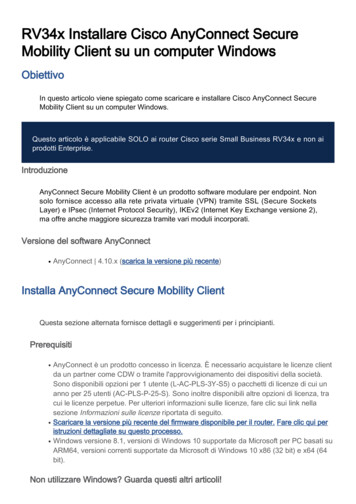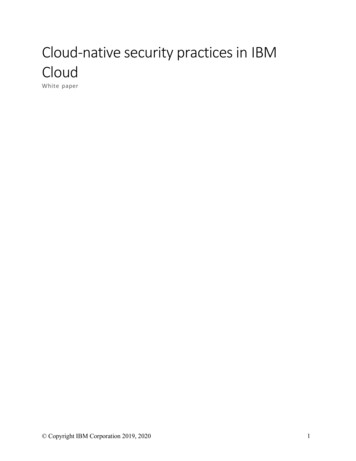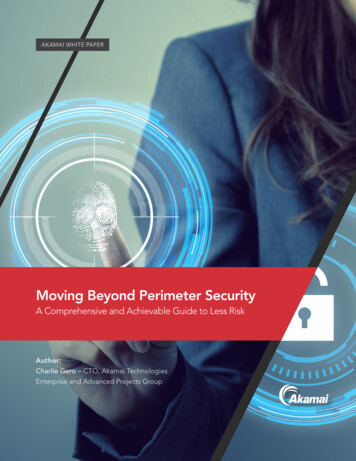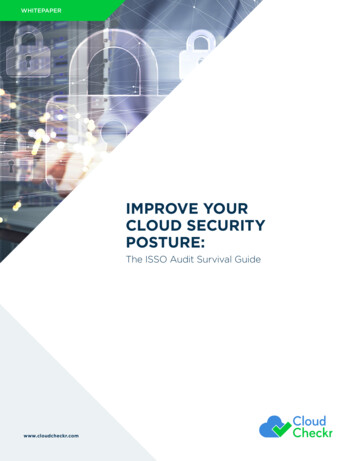
Transcription
WHITEPAPERIMPROVE YOURCLOUD SECURITYPOSTURE:The ISSO Audit Survival Guidewww.cloudcheckr.com
“Without a clear understanding of what’s going on in theirIT environments, agencies cannot keep sensitive dataunder control and be confident about using powerful cloudtechnologies. Deep visibility into security incidents combinedwith user behavior analytics can help IT managers meet thischallenge and mitigate the risk of data leakage by validatingsecurity policies, increasing user accountability and detectinginsider and outsider threats at early stages.”- ALEX VOVK GCN MAGAZINE, JAN 2017OVERVIEWIn 2016, the Federal Risk and Authorization Management Program (FedRAMP) certified the twomarket-leading governmental cloud offerings, Amazon GovCloud (US) and Microsoft US Gov, to thehighest level of compliance.This represented a major breakthrough for public sector IT, finally opening up the full potential ofcloud adoption in the federal space.But, as agencies seek to become more agile, more efficient and provide a better service toAmerican citizens, they must overcome significant challenges to cloud migration.First and foremost, the sensitive nature of their workloads means they face a higher threat of asecurity breach. As a result, they must adhere to strict compliance standards to protect the securityand integrity of their data.At the same time, IT teams face a steep learning curve as public sector cloud adoption gathersmomentum. They’ll need to learn new technologies, adjust to a complex and dynamic cloudenvironment and embrace a new approach to infrastructure security.In this paper, we outline the key differences between on-premise and cloud-based security, considerbest practices for improving your cloud security posture and offer five action points you shouldimplement straight away.But, first, let’s explore three fundamental concepts that are central to our understanding ofcloud infrastructure security in the federal space—the Shared Responsibility Model, complianceframeworks and governmental clouds.WHITEPAPER: A Survival Guide For The Public Sector2
Shared Responsibility ModelWhen you run our own on-premise systems, you are responsible for all aspects of your IT security—from your physical hardware to your data, applications and operating systems.But, when you move to the cloud, you hand over responsibility for the host operating system,virtualization layer and physical security of facilities to your cloud service provider.Meanwhile, you’re still responsible for everything that’s in your control, such as your guest operatingsystem, identity and access management, encryption, and secure coding practices.To clarify who is accountable for each aspect of security, cloud providers use a framework knownas the Shared Responsibility Model. Currently, there is no industry standard, so shared responsibilitymodels differ from vendor to vendor. However, they all serve the same fundamental purpose—to help customers understand their obligations and ensure both parties collectively provide fullsecurity coverage. FIGURE 1:Amazon’s Shared Responsibility Model. (Source: AWS)Cloud service providers generally have far more security resources and expertise than most federalagencies have at their disposal. So with the right people, technology and processes in place, your ITworkloads will be more secure in a cloud-based environment than in your on-premise data center.WHITEPAPER: A Survival Guide For The Public Sector3
KEY COMPLIANCE FRAMEWORKSDifferent information security frameworks apply to different governmental organizations. However,the following layers of compliance apply to all federal agencies that host IT workloads in the cloud:FISMAFISMA is the all-embracing legislative frameworkfor protecting the security, integrity and availabilityof federal information and information systems. Tomeet FISMA compliance requirements, governmentalagencies and private contractors that handle federaldata must:››Maintain full visibility over their information››system inventory.››Define the security objectives for theirinformation and information systemsbased on the level of impact in the event ofunauthorized access, loss of data or servicedisruption.Implement a NIST SP 800-53 category ofcontrols that is appropriate to the securityobjectives of the organization.››Perform regular risk assessments and ensuresecurity controls remain in line with theirfindings.FedRAMPFedRAMP is essentially a streamlined versionof FISMA tailored to cloud-based systems. Itleverages the shared responsibility model ofthe cloud to facilitate FISMA compliance—byspecifying different sets of controls for thecloud provider and cloud user, thereby reducingunnecessary duplication of roles.As with FISMA, federal agencies must define their security objectives and implement theappropriate category of NIST SP 800-53 controls to protect their cloud-based systems.FIPS 199 and FIPS 200FIPS 199 categorizes your information and information systems based on the level of impact to yourorganization (low, moderate or high) in the event of an incident.FIPS 200 provides guidance on how to properly protect your systems, based on your FIPS 199assessment.Together, FIPS 199 and FIPS 200 provide the framework for determining the NIST SP 800-53baseline controls that are appropriate to your organization.WHITEPAPER: A Survival Guide For The Public Sector4
NIST SP 800-53NIST SP 800-53 is the component of FISMA thatfocuses on the specifics of securing your federalinformation.It is a library of security controls, which are brokendown into different categories according to the level ofrisk to data.It’s important to remember that NIST SP 800-53 is a set of minimum requirements and that it’sgood practice to consider additional levels of security and resiliency to protect your cloud-basedassets. FIGURE 2:A multi-tiered approach toFISMA complianceGOVERNMENTAL CLOUDSGovernmental clouds are isolated cloud vendor regions designed to meet strict regulatoryrequirements for hosting sensitive public sector workloads.They are exclusively available to governmental bodies at national, state and local level, as well asauthorized contractors that handle federal data. They are certified to a broader range of compliancestandards than conventional cloud regions, are operated by vetted US citizens and enforce strictaccess criteria.WHITEPAPER: A Survival Guide For The Public Sector5
Not all US agencies are under obligation to use a governmental cloud. In these cases, they maychoose to host their workloads in a standard region that meets their FISMA compliance needs.Nevertheless, security-conscious agencies may still prefer to use a dedicated cloud environment,where tighter access restrictions provide an added level of protection and assurance.Leading cloud vendor AWS currently operates one standard US governmental region, GovCloud(US-West), which consists of two Availability Zones. However, it is due to launch a secondGovCloud region later in 2018. Microsoft Azure offers four standard governmental regions, althoughthe availability of services varies considerably between them. Specialist Governmental CloudsIn addition to their standard governmental regions, AWS and Microsoft Azureprovide specialist governmental clouds for use by US intelligence and defenseagencies respectively.Amazon’s Secret Region is a sequestered cloud environment built specificallyfor the CIA to support a full range of data classification levels, includingSensitive, Secret and Top Secret.Microsoft Azure’s military offerings, US DoD East and US DoD Central, aretwo physically separated regions designated for the US Department ofDefense (DoD) under the DoD Cloud Computing Security RequirementsGuide (SRG).ON-PREMISE VS CLOUD SECURITYWhile a move to the cloud can relieve the burden of many security responsibilities, it also presentsnew challenges to protecting your information systems.This is because the cloud is a very different computing environment from traditional ITinfrastructure, requiring a different approach to cybersecurity.On-premise security systems are designed to protect static physical environments and focusprimarily on preventing outsiders from penetrating the corporate network perimeter.However, the cloud is dynamic virtual infrastructure, where IP addresses frequently change andusers continually spin up, scale and close down resources.Moreover, you can provision these resources in just a matter of clicks. So without securityprocedures in place, such as strict enforcement of infrastructure templates, users can easilymisconfigure new environments with insecure settings, exposing your systems to attack.WHITEPAPER: A Survival Guide For The Public Sector6
On top of that, the cloud is a shared IT environment, making it unsuitable for resource-intensivescanning methods, which can have a negative impact on other customers.This all means that, while many traditional security methods still apply to the cloud, you’ll also needto take on new responsibilities, such as:››Continuously monitoring and managing system configurations››Maintaining full visibility over your entire cloud inventory››Tagging resources so you know exactly who is accountable for each of the services you’rerunning at any given time Differences Between On-Premise and Cloud SecurityFocus of on-premise securityFocus of cloud securityIntrusion prevention at outerperimeterIntrusion prevention on individualworkloadsPhysical network devices onendpointsCloud vendor APIsPacket sniffingConfiguration optionsCLOUD BEST PRACTICESSo now we’ve covered the background to public sector cloud security, let’s move onto the bestpractices you should follow for improving your security posture.The following are the five key areas of focus you should address to minimize the risk of a securityviolation:1. Workload SecurityFirst you should look to break up your applications into a network of smaller loosely coupledmicroservices. This will enhance security by introducing additional layers of isolation to yourapplication.WHITEPAPER: A Survival Guide For The Public Sector7
As well as traditional coding threats, such as SQL injections and cross-site scripting (XSS), youshould also take measures to prevent new cloud-based vulnerabilities—such as API exploits,whereby an attacker gains unauthorized access to your API keys.2. AutomationInfrastructure-as-code (IAC) tools, such as Chef and Puppet, offer a fast and reliable way toprovision secure and compliant application environments. In addition, you should leveragecontinuous integration (CI) and continuous delivery (CD) tools, such as Jenkins, to incorporatesecurity tasks into your software deployment pipeline.3. Asset ManagementYou can’t manage what you don’t know you have. So you should have the tools in place to ensurecomplete visibility over all your cloud assets. At the same time, you should introduce safeguardsto prevent cloud sprawl—the uncontrolled proliferation of resources, which can leave yourinfrastructure vulnerable to attack.4. EducationYou’ll need to train staff in new technologies, educate them in the differences between cloud andtraditional IT infrastructure, and nurture cloud security awareness. Third-party tools can help plugthe skills gap as you transition to the cloud, automatically taking care of many of your securitymanagement tasks.5. MonitoringMonitoring tools are indispensable to maintaining the security posture of complex and dynamiccloud environments, which consist of a diverse array of compute, storage and other infrastructureservices. In particular, they play an especially important role in configuration management.They can track system settings and alert you to potential threat signals, such as changes topermissions, failed and unauthorized access attempts, disabled logging systems and inactive userprofiles.More advanced tools can also provide automated responses to undesirable or potentially harmfulchanges in your infrastructure, acting quickly to address vulnerabilities.WHITEPAPER: A Survival Guide For The Public Sector8
Promoting Good Cyber Hygiene Act of 2017In June 2017, the United States Congress introduced the Promoting GoodCyber Hygiene Act, which instructed NIST to develop a set of voluntary bestpractices for maintaining infrastructure security.The mandate aims to establish an official list of cybersecurity controls that canbe implemented by federal agencies, private companies and any individual ororganization utilizing an information system.The guidelines have yet to be finalized. However, they’re expected to draw onmany existing recommendations, such as those published by the Center forInternet Security (CIS), providing a universal list of basic controls.Although voluntary, they could represent the first step towards a mandatoryrequirement for organizations with systems that handle federal or othersensitive data.5 SUPERFAST WAYS TO SECURE YOUR CLOUDMaintaining good cyber hygiene is no easy challenge. And we can barely scratch the surface bygiving you a general overview to improving your cloud security posture.However, you can still take a number of simple and immediate steps, which can make a significantimpact on the security of your cloud infrastructure.And the great news is that many of them take just a matter of minutes.The following is our top five list of action points that you should implement straight away:1.Enforce a stronger password policy: Make it harder for attackers to crack passwords byrequiring a minimum length and at least one number, uppercase letter, lowercase letter or nonalphanumeric character. And consider setting an expiry date on passwords, so users changethem periodically.2.Set up multi-factor authentication (MFA): All leading cloud service providers support multifactor authentication via devices such as smartphones and FIDO key fobs. Start by focusingyour attention on users with administrative status or access to sensitive information.3.Lock down all ports that don’t need to be open: You should also consider keeping sensitiveendpoints, such as port 22, closed—opening them temporarily only when you need them.4.Remove all unused and unnecessary resources: Keep your attack surface to a minimum byremoving unused and underutilized virtual machines and other cloud infrastructure. Not onlywill you improve your security posture but reduce your cloud costs at the same time.WHITEPAPER: A Survival Guide For The Public Sector9
5.Enable all log recording services: Cloud logging services capture information thatcould provide vital clues about a potential security breach. Turn on logging services,such as AWS CloudTrail and Azure Network Security Group flow logs, to help youdetect suspicious activity as early as possible.“Many cloud service providers, such as Amazon Web Services,Microsoft and Google, invest heavily in incorporating higherlevels of security into their products to continue buildingconfidence that their data is more secure.”NEVILLE CANNON RESEARCH DIRECTOR AT GARTNER, JANUARY 2016STAY AHEAD OF THE HACKERSMost governmental organizations simply cannot match the huge levels of investment thatthe leading cloud providers put into securing their services. And now security is rapidlybecoming a key driver of public sector cloud adoption rather than a reason to avoid it.But what’s also helping federal agencies make the transition to the cloud is the growingecosystem of third-party cloud management tools—which include solutions designed toimprove your security posture.Better still, some of these offerings provide best practice checks and recommendationsthat are aligned to the compliance frameworks that apply to federal agencies.Nevertheless, it’s important to remember that these tools not only help ensure you meetyour compliance obligations. They’re also essential to staying ahead of the hackers,helping to prevent a malicious attack and the potentially devastating consequences itcould bring.Need CloudCheckr for yourorganization? Learn more atwww.cloudcheckr.com.342 N GOODMAN ST,ROCHESTER, NY 146071-833-CLDCHCKwww.cloudcheckr.com
FedRAMP FedRAMP is essentially a streamlined version of FISMA tailored to cloud-based systems. It leverages the shared responsibility model of the cloud to facilitate FISMA compliance—by specifying different sets of controls for the cloud provider and cloud user, thereby reducing unnecessary duplication of roles.

